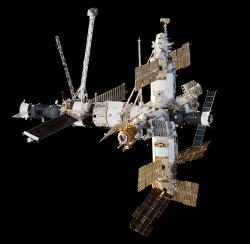Mir Space Station

the shuttle Endeavour
Credit: NASA
Russia's space program operated the Mir space station for 15 years from 1986 to 2001. This was 3 times longer than planned. Mir was the most massive spacecraft in space until the launch of the International Space Station in 1998. Mir was in orbit 350 km above the Earth's surface, and travelled at an average speed of 27,700 km per hour. This means it completed almost 16 orbits of Earth each day.
Mir was the first modular space station. It was made of 7 sections or 'modules'. Cosmonauts pieced the station together between 1986 and 1996, whilst it was in orbit. Solar power from the Sun generated the electricity which supported the station and its crew. Mir was a science lab in space where cosmonauts carried out experiments in microgravity. Mir's crew studied, biology, physics, Earth's weather and spacecraft technology. Mir's labs were also the place where astronauts grew the first wheat from seed in outer space.

the shuttle Atlantis
Credit: NASA
Mir was the first research station in orbit where crew could live for long periods of time. There was a crew member on board Mir for 3,644 days (nearly 10 years) without interruption. The International Space Station beat this record in October 2010. Mir still holds the record for the longest single human space flight by Valeri Polyakov. He was on board the space station for 437 days and 18 hours between 1994 and 1995. Three astronauts could live on board Mir at a time, but more astronauts could visit for shorter periods. The first British astronaut, Helen Sharman, visited Mir in 1991.
Russian stopped funding the Mir mission in 2001 and took the station out of orbit. It re-entered the Earth's atmosphere, burning up as it fell. Any unburned debris landed in the Pacific Ocean. It's thanks to the success of Mir that the International Space Station was designed, built, and launched.

